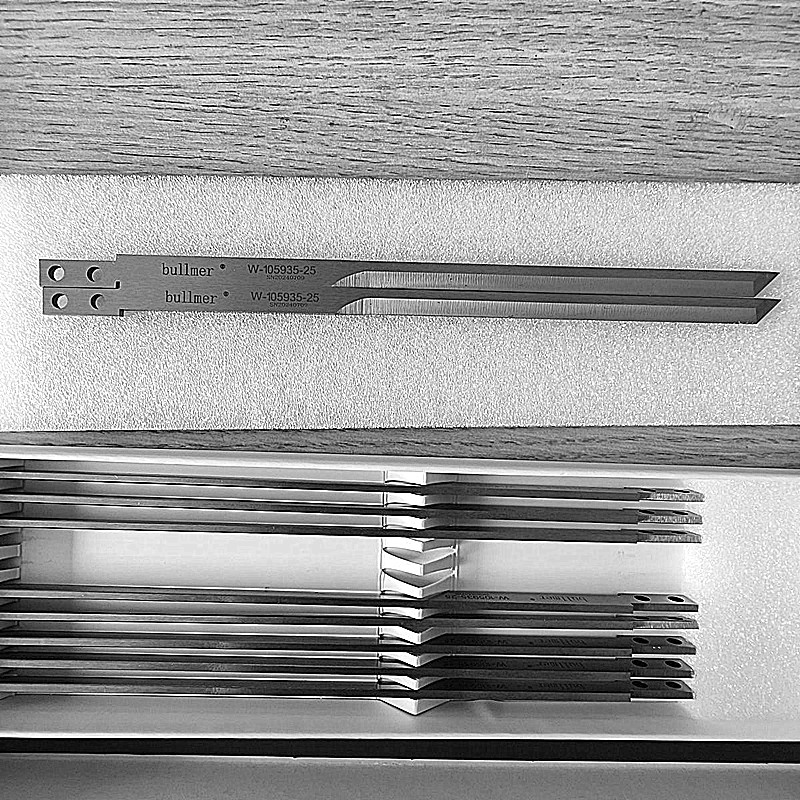How often should the Bullmer Procut knife blades be sharpened
based on general knife maintenance principles and industrial cutting blade practices, the sharpening interval depends largely on usage intensity, material being cut, and cutting precision required.
For industrial CAD cutting blades like the Bullmer Procut 105935-B/01411, typical maintenance involves:
- Sharpening the blade after noticeable loss of cutting performance or when the blade no longer cuts cleanly through multi-layer materials.
- Following the machine manual’s guidance on sharpening cycles, often involving grinding the blade 4–5 times after installation or blade change to restore sharpness.
- Regular daily checks and cleaning to prolong blade sharpness and reduce the frequency of sharpening.
By analogy with general knife sharpening advice, blades used heavily in industrial applications may require sharpening anywhere from weekly to monthly depending on workload, while lighter use may extend this interval.
In summary, sharpen Bullmer Procut knife blades as soon as cutting quality degrades, typically monitored through daily machine operation checks, and perform blade grinding/sharpening procedures as recommended by Bullmer’s maintenance instructions to maintain optimal cutting performance.
What are the best techniques for sharpening Bullmer Procut knife blades
The best techniques for sharpening Bullmer Procut knife blades, which are industrial multi-layer CAD cutting blades, involve careful angle control, progressive grit sharpening, and proper finishing to maintain a durable, sharp edge suitable for precise cutting tasks. Key recommendations based on expert knife sharpening principles are:
- Use Appropriate Sharpening Tools: Employ whetstones or diamond sharpening stones, starting with a coarser grit (around 200-400) if the blade is dull or damaged, then progressing to finer grits (1000-3000) to refine the edge and achieve a smooth, sharp finish. Diamond stones are especially effective for harder industrial blades.
- Maintain Correct Sharpening Angle: Hold the blade at a consistent angle appropriate for the knife type-typically between 15° and 20°. For Bullmer Procut blades, maintaining a steady angle ensures an even edge and prevents damage. Consistency is critical during sharpening strokes to form a durable edge.
- Sharpen Both Sides Evenly: Alternate strokes on each side of the blade to maintain symmetry and balance of the cutting edge. This prevents uneven wear and ensures smooth cutting performance.
- Remove Burrs and Polish the Edge: After sharpening, use a leather strop or fine honing rod to remove any burrs (tiny metal fragments) left on the edge, polishing it to a razor-sharp finish. This step enhances cutting efficiency and blade longevity.
- Regular Maintenance with Honing Rods: Between sharpening sessions, use ceramic or diamond honing rods to realign the blade edge, preserving sharpness and reducing the frequency of full sharpening
- Safety and Inspection: Before sharpening, inspect the blade for damage or irregularities. Sharpen in sections if needed, applying consistent pressure and avoiding excessive thinning that could weaken the blade.
In summary, the best technique for sharpening Bullmer Procut knife blades involves starting with a coarse abrasive to reshape the edge if needed, progressing to finer abrasives for edge refinement, maintaining a consistent sharpening angle around 15°–20°, alternating sides evenly, and finishing with burr removal and polishing using a strop or honing rod. Regular honing between sharpenings helps maintain edge quality and prolongs blade life.
What are the common mistakes to avoid when sharpening Bullmer Procut knife blades
Common mistakes to avoid when sharpening Bullmer Procut knife blades include:
- Inconsistent sharpening angle: Maintaining a steady, consistent angle throughout sharpening is crucial. Changing the angle during strokes or between sides leads to uneven edges and reduced cutting performance. Locking your wrist or using guides can help keep the angle steady, typically around 15°–20° for industrial blades.
- Applying incorrect pressure: Too much pressure can damage or over-thin the blade edge, while too little pressure results in ineffective sharpening. Apply moderate, even pressure along the entire blade length to ensure a uniform edge.
- Rushing the process: Sharpening requires patience. Hurrying can cause uneven sharpening, blade damage, or injury. Take your time to sharpen evenly and check progress frequently.
- Not preparing sharpening stones properly: For whetstones, soaking and lubricating them before use is essential for efficient sharpening and to avoid shortening blade life.
- Ignoring burrs and edge imperfections
We provide professional sharpening services for carbide blades , maintaining their original blade geometry.
Our service conducts sharpening and regeneration of tools, which includes assessment of quality and consumption status.
In addition, to increase the life of blades we offer additional PVD coatings to increase their life.
Applications for : ESKO Kongsberg, Zund, Bullmer Premiumcut, Lectra, Teseo, iEcho, Kuris, Atom, Comelz, Aristo, Blackman & White, etc.
Shenzhen Oyea Global sales: ensuring availability across Europe, the USA, the Middle East, and Asia with efficient shipping and customer service.Sold To Germany, France, The United Kingdom, Poland, The United States, Russia, Vietnam, Thailand, Indonesia, Singapore, The Netherlands, Switzerland, South Korea, Japan, Turkey, The Philippines, Hong Kong, Taiwan, Italy, Spain, Hungary, The Czech Republic And Other Countries Or Regions
PREV : How to properly install and adjust JWEI J201J202J203J204J205J206J208J301 knife blade in JWEI NEXT : Kongsberg Esko Bld-Df113 Bld-Df212 Bld-Df112 Bld-Df213 Bld-Rc110 Cutting Blades






